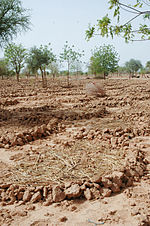Semicircular bund
Appearance
(Redirected from Demi-lune (agriculture))

A semi-circular bund (also known as a demi-lune or half-moon) is a rainwater harvesting technique consisting in digging semi-lunar holes in the ground with the opening perpendicular to the flow of water.[1][2]
Background
[edit]These holes are oriented against the slope of the ground,[3] generating a small dike in the curved area with the soil from the hole itself, so they capture the rainwater running downhills.[4]
These structures allow water to seep into the soil, retaining in the subsoil a greater amount of moisture. But also, it prevents the loss of fertile soil.[5]
Semi-circular bunds are used to reforest arid zones with irregular rain patterns, allowing the growth of plants and trees, such as in the Sahel.[6]
See also
[edit]References
[edit]- ^ "Semi-circular bunds". United Nations. Convention to Combat Desertification.
- ^ "Water harvesting techniques". FAO.
- ^ Justdiggit. "Water Bunds | Earth Smiles". Justdiggit. Retrieved 2024-10-20.
- ^ "Semi-circular bunds". Freie Universität Berlin. 2 August 2016.
- ^ Peter, Kathuli; Itabari, J.K. (January 2015). "In Situ Soil Moisture Conservation: Utilization and Management of Rainwater for Crop Production". Adapting African Agriculture to Climate Change. Climate Change Management. pp. 127–142. doi:10.1007/978-3-319-13000-2_11. ISBN 978-3-319-12999-0.
- ^ Page, Thomas (18 July 2022). "Greener pastures: Can ancient eco-engineering help fix our degraded landscapes?". CNN.
Wikiversity has learning resources about Semicircular bund
